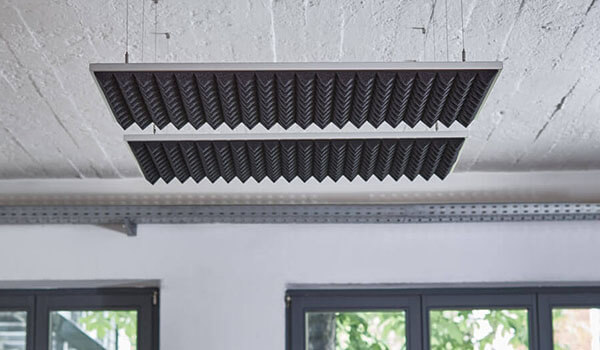How to block out noise from upstairs neighbors? This question keeps popping into your head more frequently as you now spend a large amount of time staying at home.
You’re just about to fall asleep as you hear some extremely exaggerated stomping feet across the upper floor. Even worse, the noise keeps coming back every day, making your bedtime nothing short of unbearable.
That’s when you need to find a way to put an end to the issue, or at least, bring down the noise.
Below are a few soundproofing methods that you can apply to minimize the noise transference from the house directly above.
How to Reduce Noise from Neighbors on Upstairs Floors
There are many options when it comes to soundproofing your house or apartment against upstairs noise. Let’s check them out:
1. Find Out The Source Of The Noise And Talk To Your Neighbors
If you happen to live underneath noisy upstairs neighbors, you’ve probably considered asking the property manager to step in and call those tenants to talk about the issue.
Unfortunately, most property managers are not strong advocates for directly dealing with the tenants in question, and always hope you and your neighbors will reach a compromise yourselves.
The first step in this process is to identify the sources of unwelcome noises that irritate you. There are two common noise types that you might be suffering from.
Airborne Noise is derived from TV, phone ringing, squeaky fan, noisy fridge, people having conversations, or dogs barking. It travels through the air, and when hitting a building element, in this case, is the floor above, causes vibration.
These vibrations travel further below the floor, going through your ceiling to reach your ears.
Impact Noise comes from the balls bouncing off the floor, door running, feet stomping, and heavy furniture moving – any physical impact on solid surfaces. Impact noise is stronger and can travel farther through concrete, woods, and other dense building materials.
You might experience either airborne noise or impact noise, or even worse, a combination of the two. Severe exposure to these noise types can render day-to-day living in your apartment nothing short of a nightmare.
Once figuring out what annoys you the most, you may want to talk to your neighbors in person. In case you’re not comfortable with having a direct conversation, leave them a note under the door.
Whichever way you choose, keep in mind to make your neighbors feel that you’re requesting to collaborate with the desired outcomes is a solution to the noise problem, not a demand that you want to impose on them.
Mention the type of noise you hear and how it affects your ability to work and function normally. Hopefully, you’ve got understanding neighbors to make an effort and work the problem out together.
Alternatively, you may need to check out other approaches to dampen the noise on your own.
2. Using Acoustic Foam
The acoustic foam is another great idea on how to stop noise from upstairs to downstairs. It’s also economical, easy to install soundproofing tool out there. The only drawback of using foam panels is its lack of attractiveness that may ruin the look of your whole room.
Depending on the original size of the panels, as well as your personal preferences, you may want to cut them into smaller pieces. Then use some kinds of sealants to stick them to the ceiling.
Many people prefer to use T-pins to affix acoustic foam panels, which hold the panels securely against the ceiling, but they often end up with tiny holes all over the ceiling.
We highly recommend using a construction adhesive like green glue or 3M command strips with Velcro backing on the back of the panels to stick them to the ceiling. It is easy to use and holds up as nicely as the T-pins.
Alternatively, you can put the foam panels on thick cardboards using adhesive and mount cardboards on the ceiling. This approach allows you to minimize the ceiling’s damage while soundproofing your apartment against the upstairs noise.
Before installing the acoustic foam panels, make sure to clean and remove any debris on the ceiling. Any protrusion on the ceiling will make the installation more challenging, and the final results will not be as fine-looking as you should expect.
The most critical factor while choosing acoustic panels is the density. The denser the foam is, the better sound absorption and flutter echo prevention your room can enjoy. Moreover, you can even use moving blankets to reduce noise as a cheaper alternative.
3. Install Drywall to The Ceiling
Drywall is basically a panel of gypsum sitting between thick layers of facer or backer paper. It has become popular as a means of reducing sound transmission for households.
Several reliable brands of sound-dampening drywall are available, including QuietRock, National Gypsum’s SoundBreak, and CertainTeed’s SilentFX.
It is advisable to use a drywall panel of 5/8-inch thickness against the ceiling. The installation is a simple process. To start off, apply some sound dampening material to the back of the drywall for additional STC points.
Then screw the panels to the joists of the ceiling. If the noise is extremely unbearable, you will need to add two layers of drywall for more soundproofing capability.
In case your ceiling already has a layer of drywall in place, you can add another layer.
As a rule of thumb, the denser your ceiling is, the better it is at preventing noise from entering the room. The extra drywall sheet will enhance the density of the ceiling, thus further reducing the noise from the upstairs apartment.
Despite not being very durable, drywall is an easy and cost-effective method of noise reduction. It’s also fire-resistant, thanks to the nature of gypsum. On top of that, if properly installed, drywall panels don’t necessarily compromise your house’s aesthetic as acoustic foams.
4. Install Resilient Channels
A resilient channel is a holed metal bar used to attach at right angles to the ceiling joists or studs, forming a grid-like network. If installed properly, this tool helps boost the performance of other sound-absorbing materials, such as drywall.
The whole idea behind the resilient channel is to reduce the contact between the drywall and the ceiling.
Instead of having your drywall come into contact with the whole joists all along with the entire ceiling, the only contact point between them is through the screw connecting the joist and the resilient channel.
Additionally, these channels can move slightly independently from the whole ceiling system and prevent all the vibrations from going down or up.
We find that installing resilient channels involves more work and effort than any other soundproofing materials.
First off, attach the resilient channels at the right angle to the joists. Fasten them with proper screw fasteners.
It is advisable to keep the resilient channel spacing 24 inches on center, with joist spacing being 16 inches on center. The spacing less than 24 inches might reduce the system’s effectiveness.
Oftentimes, drywall can be installed directly to the wood framing. The frame might get wet, shrink, and move a whole lot over time, creating many cracks in the drywall.
In such cases, the resilient channel can help isolate the drywall from the framing, thus reducing the impact noise from your ceiling.
Yet, the lack of proper installation can easily lead to the failure of the whole system of channels.
If you decide to install these channels yourself, carefully follow the instructions coming with the channels to properly install them on your own. Or else, you can have them installed by a professional team, who often take over the installation of the drywall for your convenience.
5. Make Changes to The Floor Above Your Ceiling
One more tip you can try is to deal with the noise from upstairs neighbors. Perhaps a poorly soundproofed floor is the main root of all the objectionable and disturbing noise you’ve tolerated. However, this will be much more difficult as it depends on your upstairs neighbor.
If they are cooperative, you can suggest the following ways. If they don’t cooperate, then you should find another way.
There are several ways to soundproof the floor in an apartment, which don’t require too much effort and time.
1. Carpets And Rugs
For simple yet effective soundproofing solutions, carpets and rugs are top of the list. These accessories will add more density and softness to the floor, thus absorbing the noise from upstairs floors better.
You might want to go a step further and install sound deadening underlayment before laying a carpet or rug. By doing this, you’ll add an additional layer to absorb the noise.
2. Interlocking Floor Mats
An interlocking mat is one of the most affordable and simple ways you can try to soundproof the floor.
The installation is not a complicated DIY project; lay the first piece of the mat down in any corner of the room, and start connecting other pieces. The mats will enhance the density of your floor, thus reducing the noise level from upstairs floors.
3. Soundproof Padding
Suppose your neighbors already have some carpets to cover the floor; you can suggest them using carpet padding. It will further reduce noise transmission through the floors.
Carpet padding is easy to lay down without help from professionals. Pull up the carpets, roll out the padding, secure it with nails or glue, and lay the carpets back to finish the installation.
4. Mass Loaded Vinyl (MLV)
MLV excels in preventing sound transmission and containing vibrations. MLV is commonly installed as an underlayment for the floor. When used in combination with soundproofing compounds such as green glue, it provides the ultimate noise reduction.
Conclusion
That’s all the hacks on how to reduce noise from upstairs floors, especially from noisy neighbors. If you suffer from a severe noise issue, it’s better to combine two or more methods to bring the noise to manageable levels.
As everyone seems to spend most of the time at their home, unwanted noise is an inevitable inconvenience, especially in apartments with poor or run-down architecture and the apartment building design.
In addition to talking to your neighbors, guarding your house against noise with the mentioned sound absorption materials, and you’ll get an environment that is more conducive to living and working. Thanks for your reading!





